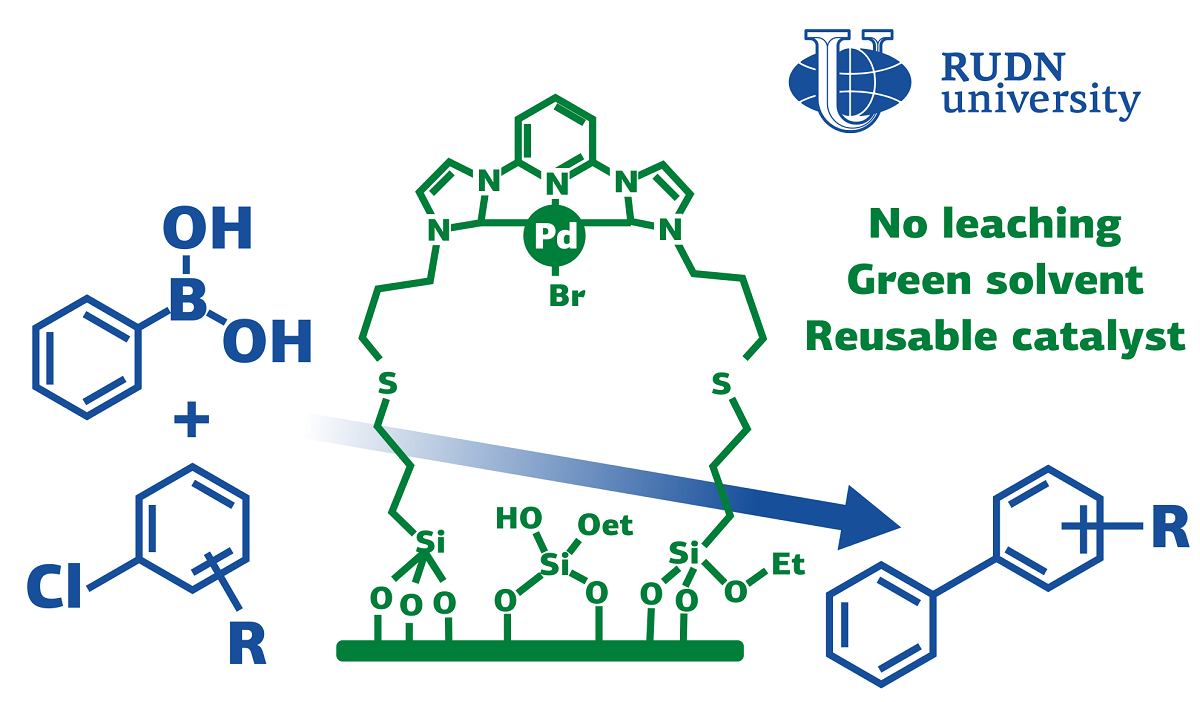RUDN chemists have created a “green” catalyst for the synthesis of complex molecules for medicine and industry

For the synthesis of complex molecules for pharmaceuticals, agrochemistry and the chemical industry, cross-combination reactions are used — compounds of two carbon atoms from different molecules. One of the cross-combination reactions is the Suzuki reaction. It requires palladium-based catalysts. The noble metal allows the reaction to be carried out effectively, but it can “wash out” and get into the resulting product. This is especially undesirable, for example, in the production of medicines.
“To stop the leaching of metal during the catalytic cycle, we propose to use organometallic compounds. The strong interaction between organic bonds and metals forms highly stable complexes. This effective interaction helps to keep the metal from leaching, ” Professor Leonid Voskresensky, Dean of the Faculty of Physics, Mathematics and Natural Sciences of the RUDN.
RUDN chemists have created a palladium nanocatalyst based on N-heterocyclic carbenes (NHC). After use, it leaves no traces of palladium in the product. The catalyst proved to be efficient and economical for the Suzuki reaction between phenylboric acid and aryl chlorides. The reaction took place at a temperature of 90 ℃ for eight hours. After that, the solid residue was washed in water and ethyl acetate, dried and the reaction was carried out again to check how the structure and effectiveness of the catalyst changed. The chemists also tested different reaction conditions — temperature, solvent and base— to find the optimal ones.
After separating the catalyst, chemists performed a spectroscopic analysis of the filtrate and made sure that it did not contain palladium. The maximum yield of the final product was 97% for one of the aryl chlorides. This is comparable to the results of other catalysts, but, unlike analogues, the catalyst consumption was less. In addition, a “green” solvent was used — an aqueous solution of isopropanol. After 10 cycles of use, the efficiency of the catalyst has practically not changed, remaining above 90%. Moreover, after the ninth use, chemists checked the structure of the nanocatalyst using a scanning electron microscope and found out that it remained almost the same as it was before the first use.
“The hybrid nanomaterial acts as a highly active catalyst in the Suzuki reaction between aryl chlorides and phenylboric acid. The catalyst has shown excellent activity and stability, it can be reused at least ten times without any significant loss of activity. After the ninth launch, the catalyst showed an almost similar structure compared to the fresh catalyst. We found no traces of palladium in the products, and leaching tests confirmed that the reaction was really heterogeneous,” — Rafael Luque, professor at the Center for Molecular Design and Synthesis of Innovative Compounds for Medicine of the RUDN.
The results are published in the journal Molecular Catalysis.
Matilda Pavlovna Mityaeva was born in 1925. In November 1942, she volunteered for frontline duty. She participated in the Great Patriotic War from November 1942 to June 1945 as part of the 53rd Infantry Division of the 475th Infantry Regiment. She was wounded twice.
The team led by Sergey Zyryanov, Head of the Department of General and Clinical Pharmacology, became the winner of the All-Russian competition of scientific projects "Technologies for Human Health".
RUDN University constantly adapts to the changes of the modern world and responds to challenges flexibly. This allows us to keep the standard of a world-class research university. The sphere of science is no exception. Peter Dokukin, Head of the Research Division, presented the updated R&D Programme at the meeting of the RUDN University Academic Council.
Matilda Pavlovna Mityaeva was born in 1925. In November 1942, she volunteered for frontline duty. She participated in the Great Patriotic War from November 1942 to June 1945 as part of the 53rd Infantry Division of the 475th Infantry Regiment. She was wounded twice.
The team led by Sergey Zyryanov, Head of the Department of General and Clinical Pharmacology, became the winner of the All-Russian competition of scientific projects "Technologies for Human Health".
RUDN University constantly adapts to the changes of the modern world and responds to challenges flexibly. This allows us to keep the standard of a world-class research university. The sphere of science is no exception. Peter Dokukin, Head of the Research Division, presented the updated R&D Programme at the meeting of the RUDN University Academic Council.